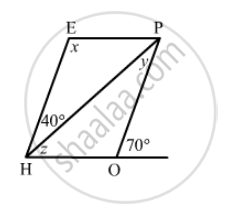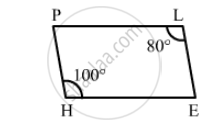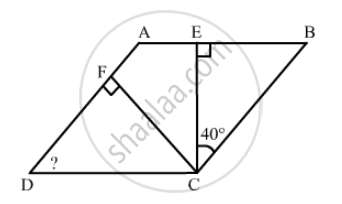Advertisements
Advertisements
Question
In the adjacent figure HOPE is a parallelogram. Find the angle measures x,y and z. State the geometrical truths you use to find them.

Solution
\[\angle HOP + 70°= 180° (\text{ linear pair })\]
\[\angle HOP = 180°- 70°= 110°\]
\[x = \angle HOP = 110° (\text{ opposite angles of a parallelogram are equal })\]
\[\angle EHP + \angle HEP = 180°(\text{ sum of adjacent angles of a parallelogram is } 180°)\]
\[110° + 40° + z = 180°\]
\[z = 180° - 150°= 30°\]
\[y = 40° \left( \text{ alternate angles }\right)\]
APPEARS IN
RELATED QUESTIONS
Can the following figure be parallelogram. Justify your answer.

All the angles of a quadrilateral are equal to each other. Find the measure of each. Is the quadrilateral a parallelogram? What special type of parallelogram is it?
Two adjacent sides of a parallelogram are 4 cm and 3 cm respectively. Find its perimeter.
Find the angles marked with a question mark shown in Fig. 17.27

In a parallelogram ABCD, AB = 10 cm, AD = 6 cm. The bisector of ∠A meets DC in E, AEand BC produced meet at F. Find te length CF.
Which of the following statement is true for a rhombus?
It has all its sides of equal lengths.
Which of the following statement is true for a rhombus?
It is a square.
Fill in the blank, in the following, so as to make the statement true:
The diagonals of a rhombus ...... each other at ...... angles.
ABCD is a rhombus. If ∠ACB = 40°, find ∠ADB.
Draw a rhombus ABCD, if AB = 6 cm and AC = 5 cm.
